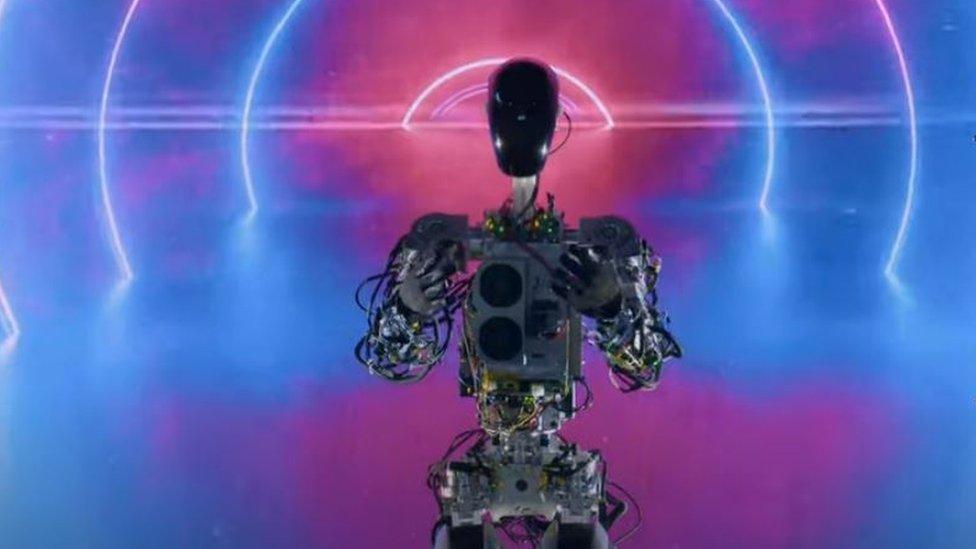Tesla's Optimus and the problem with humanoids
- Published

Optimus was unveiled at Tesla's AI (artificial-intelligence) day
Fans of Tesla and Elon Musk were enthralled by the unveiling of Optimus, a prototype humanoid robot, in California last week.
I also enjoyed the theatrics - but I'm not alone in wondering why, apart from the wow factor, Optimus had to be human-like.
And while the fans hate any perceived criticism, Mr Musk himself has said Optimus is nowhere near market-ready.
The argument made for humanoids is they are best equipped to work with human tools, in human environments. People may feel more comfortable interacting with something that looks like a bit like them. And of course, they look great.
But how practical are they?
Legs v wheels
"A lot of companies work in the area of humanoids because it's interesting for the public to see," Owen Nicholson, chief executive of Slamcore, which specialises in sensor-driven vision, says.
"But wheel-based robots and even drones are so much easier to control. The amount of work that goes into just getting a humanoid to stand upright is huge."
Some of the falls experienced by competitors in the Darpa Robotics Challenge
The robotics behind Optimus look sound - Tesla is not exactly a novice at all this - but, Mr Nicholson says, by its release, the machine will have evolved into something physically more practical.
"I'd put money on them having more wheel-based robots," he adds.
Reporting robots
In my job, I have seen lots of robots - all shapes and sizes - designed to clean, care for the elderly, teach, perform surgery, work as receptionists and tour guides, play Scrabble and chess, sing and dance, mix cocktails, pack shopping, deliver groceries, have sex, perform search and rescue and build cars.
You name it, somebody is probably trying to build a robot for it.
Some of them work better than others - and demonstrations rarely go to plan.
But what the sci-fi films fail to show is all the wires, the pre-programming and the very brief battery life. As I discovered when trying to film them, early football-playing robots could last for only 10 minutes.

Trying to make friends with Sophia the Robot
I have had excruciating "conversations" with conversational robots, watched many devices fail to complete the tasks they were designed for, and seen the panic in the eyes of the executives in the room when a developer brandishing a bunch of wires says: "We just need to reboot."
But robots have advanced considerably faster than humans in the past decade. The robots of 2022 are far more skilled than those I first saw, in 2008, whereas I have acquired little more than a few grey hairs.
Time and time again though, the most impressive performers tend not to look like people. Precision-surgery robots, warehouse robots, window-cleaning robots - none of them is remotely humanoid.
If the face fits
Expectation may be part of the problem.
Humanoids might be expected to function like people, performing a variety of different tasks - mowing the lawn, making a sandwich, cuddling a baby.
But Prof Helen Hastie, of the National Robotarium, in Edinburgh, says robots are a very long way off being able to multi-task.
"What's most important is that the robot is fit for the task it is designed for," she says.
Boston Dynamics' doglike quadruped Spot is ideally suited to rough terrains, such as bombed-out buildings - but a robot designed to, say, work in a kitchen may need no legs at all.
Robots designed to work with vulnerable people, for example in care homes, might be better suited to looking a bit more human - but not too much.
It is a phenomenon known as the uncanny valley - if something looks human-like but not believably so, it becomes unnerving and even frightening.
As Prof Helen Hastie says: "If it's too human-like, it will put off the human."
- Published1 October 2022

- Published8 June 2015
